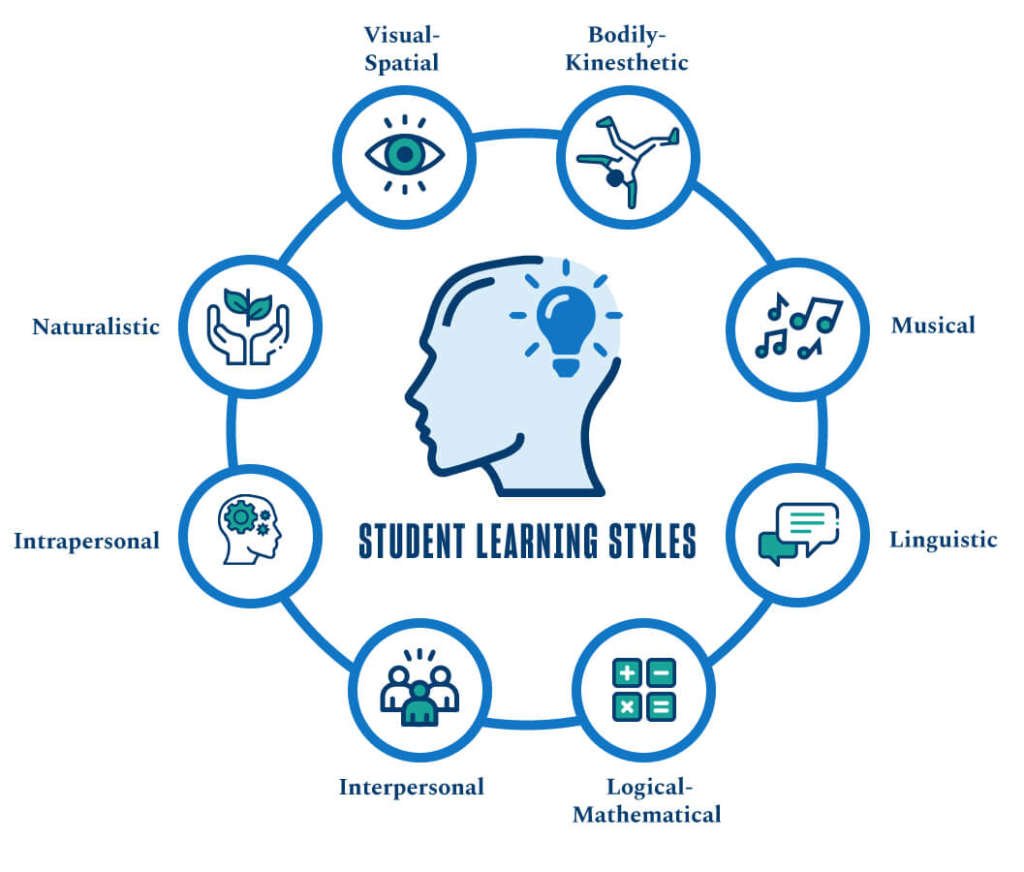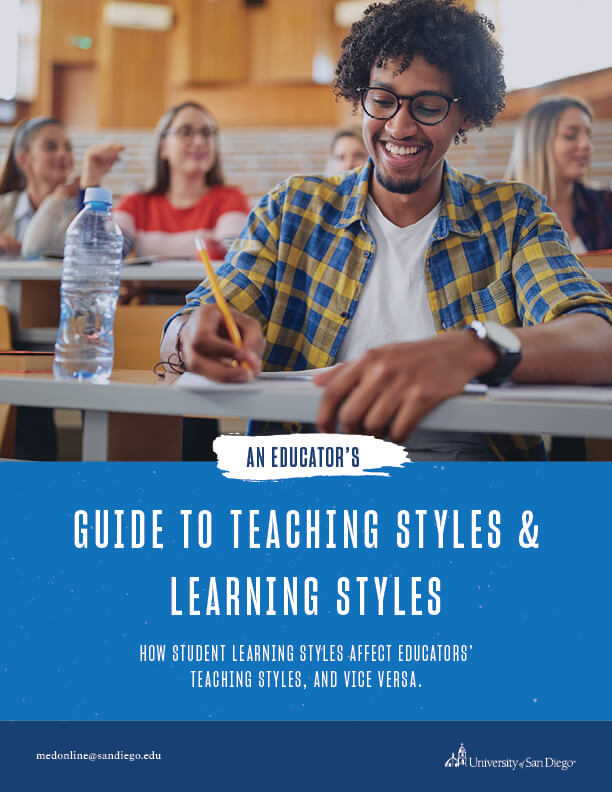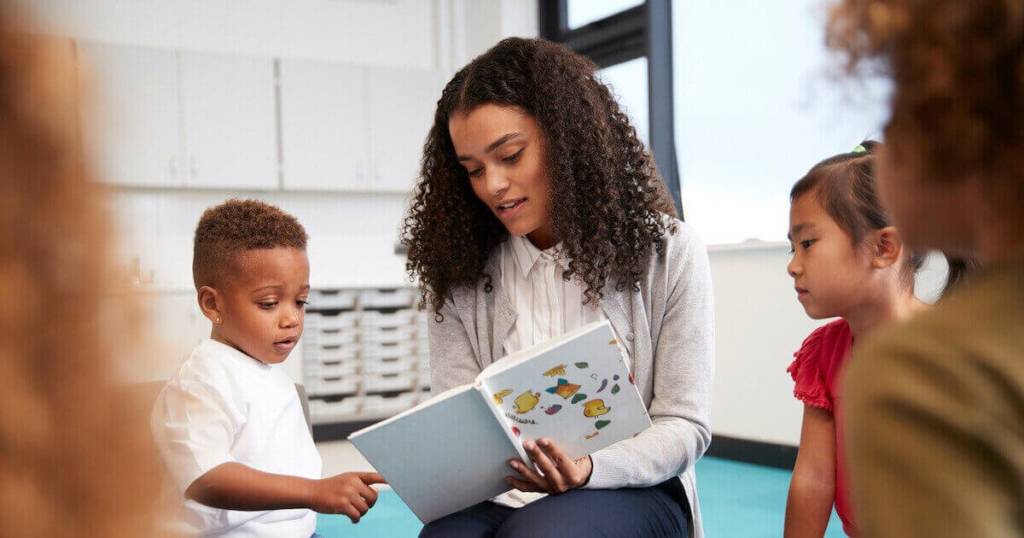Hello, welcome to “An Educator’s Guide to Teaching Styles & Learning Styles.” Today’s discussion topic: How student learning styles affect educators’ teaching styles, and vice versa. Here is the syllabus for our key discussion points:
- Individual Student Learning Styles
- The Theory of Multiple Intelligences
- Teacher-Centered vs. Student-Centered
- Teaching Styles: 5 Approaches to Education
- Lifelong Education for Teachers: Impact of an MEd
- Follow-up Quiz
Editor’s note: The decision to playfully craft this blog post to feel like a classroom lesson is a writing strategy intended to engage the reader for what we hope will be an informative discussion of important educational concepts and practices.
Student Learning Styles
If you are a teacher, you know that no two students are the same and that there is a spectrum of different learning styles. An educator’s teaching style, therefore, can greatly impact a student’s ability to learn and comprehend. This is why knowledge of different learning styles is essential for teachers.
Does Andrea learn most effectively through images and graphics? She may be a Visual learner.
Does Jeremy seem to grasp the material best by listening to lectures, asking questions and participating in group discussions? He may be an Auditory learner.
Do Max and Emily prefer to gather information by reading, taking notes and writing reports or essays? They may be Reading/Writing learners.
And what about Dylan? She is very hands-on, and seems to enjoy taking things apart and putting them back together — to learn by doing. She may be a Kinesthetic learner.
That’s one common breakdown of the spectrum of learning styles, but of course it is not the only one. (One of the first lessons you learn when researching learning styles is that there are many different theories.)
One is the Theory of Multiple Intelligences, developed in the late 1970s and early 1980s by Harvard educator Howard Gardner (see video), who believed that there are eight distinct “intelligences” that are closely connected to learning. These are:
- Visual-Spatial — The ability to conceptualize and manipulate large-scale spatial arrays (e.g. airplane pilot, sailor), or more local forms of space (e.g. architect, chess player).
- Bodily-Kinesthetic — The ability to use one’s whole body, or parts of the body (like the hands or the mouth), to solve problems or create products (e.g. dancer).
- Musical — Sensitivity to rhythm, pitch, meter, tone, melody and timbre. May entail the ability to sing, play musical instruments, and/or compose music (e.g. musical conductor).
- Linguistic — Sensitivity to the meaning of words, the order among words and the sound, rhythms, inflections and meter of words (e.g. poet). Sometimes called language intelligence.
- Logical-Mathematical — The capacity to conceptualize the logical relations among actions or symbols (e.g. mathematicians, scientists).
- Interpersonal — The ability to interact effectively with others. Sensitivity to others’ moods, feelings, temperaments and motivations (e.g. negotiator). Sometimes called social intelligence.
- Intrapersonal — Sensitivity to one’s own feelings, goals and anxieties, and the capacity to plan and act in light of one’s own traits. It is not particular to specific careers; rather, it connects to the ability of every individual to make consequential decisions for oneself. Sometimes called self-intelligence.
- Naturalistic — The ability to make consequential distinctions in the world of nature as, for example, between one plant and another, or one cloud formation and another. Sometimes called nature intelligence.
The idea behind multiple intelligence theories is not that people learn in only one way, but that people are stronger in different areas and can demonstrate their knowledge and abilities in different ways. For teachers, being attuned to such distinctions can be helpful in understanding how to best connect with individual students.
YOU’RE INVITED! Watch Free Webinar on USD’s Online MEd Program >>
A Range of Different Teaching Styles
There are two main buckets that most teaching styles fall into: teacher centered or student centered. Here’s a closer look at teacher-centered instruction vs. the student-centered approach:
Teacher-Centered Approach
The teacher-centered approach to education positions the teacher as the expert who is in charge of imparting knowledge to his or her students via lectures or direct instruction. In this approach (sometimes called “sage on the stage”), students are passive actors or “empty vessels,” listening and absorbing information.
This teacher-centered style is the traditional approach to teaching, but it’s not necessarily the best. And as educators learn more about effective ways to engage learners of every style, the teacher-centered approach is looked upon less fondly than it once was. However, there are also countless examples of students being challenged and transformed by a teacher or professor lecturing about a subject they have spent their entire life exploring.
Student-Centered Approach
The student-centered approach creates more equanimity between the teacher and student, with each playing a role in the learning process. In this approach, the teacher is sometimes referred to as the “guide on the side.”
While the teacher still holds authority, he or she is more likely to act as a facilitator, coaching students and assisting them in their learning. This approach champions student choice and facilitates connections among students. A couple of styles within the student-centered approach to teaching are:
Inquiry-Based Style
This student-centered learning style encourages independence, autonomy and hands-on learning, with students leading the way and receiving guidance from their teachers.
Cooperative Style
Cooperative learning is a student-centered approach that focuses on group work and social growth. Much like the inquiry-based style, the cooperative style encourages independence and hands-on learning but puts special importance on peer-to-peer work and community.
[RELATED] Career Options Expand, Salaries Spike with a Master of Education Degree >>
Question: How many teaching styles are there?
Answer: This is sort of a “trick question” because, as you might expect, different educational theorists offer differing ideas about the range, scope, descriptions (and number) of different teaching styles.
Though this may be a case where there are no “right answers,” many educational resources break down the different styles of teaching into the following five primary categories:
Lecturer or Authoritative Style
The authoritative teaching style follows the traditional teacher-centered approach, often characterized by lecture sessions or one-way presentations. In this approach (also called the “chalk and talk” style), students are expected to pay attention, absorb the information, take notes and ask questions.
Demonstrator or Coach Style
Often used in math, science and music, the demonstrator style involves more “showing” rather than “telling” with teachers more likely to support the information with examples or experiments, demonstrations or multimedia presentations.
Facilitator or Activity Style
The facilitator/teacher is focused on promoting self-learning and helping students develop critical learning and thinking skills. A student-centered approach, it involves creating learning plans and classes that require students to explore and discover the course content in creative and original ways.
Download our free eBook here to learn the top reasons to get your Master of Education degree >>
Delegator or Group Style
Well-suited for curriculums that include or emphasize group activities, the delegator style of teaching shifts much of the responsibility for learning onto the students, who are encouraged to work together in projects connected to the lesson themes (think science labs, debates, etc.). In this style, the teacher is an active observer working to guide students in the right direction.
Hybrid or Blended Style
The hybrid approach may integrate elements of the styles discussed above, often blending the teacher’s personality and interests with those of the students. While this method is considered inclusive, enabling teachers to tailor their styles to student needs within the subject matter, some educators believe it risks diluting the learning process by placing less emphasis on in-depth study than when following a single, focused approach.
The discussion above is not intended to reduce the organic practice of classroom teaching into neat categories or to pigeonhole educators into being characterized as one “type” of teacher or another — but rather to explore different methodologies to enhance our shared understanding of the teaching experience. What it boils down to is getting to know your students and using your skills and instincts to discover the most effective ways to engage both the individual student and entire classes with your curriculum.
Getting to know each student well enough to effectively teach them is especially challenging for high school and middle school teachers who have different students every hour. What works with one student or group might not work with the next.
That’s why it’s so important for educators to have both a strong sense of the range of different student learning styles and a firm grasp of the different teaching styles and strategies you can use to be the most effective educator you can be.
>>Watch Now: Online Teaching Myths & Top 10 Best Practices for Educators
Lifelong Education for Teachers: Impact of a Master’s Degree
Educators who are motivated to develop a deeper understanding of different teaching styles, learning styles, instructional theory and much more will often pursue a Master of Education degree. Such programs not only present an opportunity to become a better educator, in many school districts obtaining an MEd will also earn teachers a salary increase.
To help expand educational opportunities for busy working teachers, the University of San Diego has developed an innovative, 100% online Master of Education degree program that gives teachers the option of earning their MEd on their own schedule, while interacting with and learning from fellow educators across the country.
The MEd specializations include:
- STEAM (Science, Technology, Engineering, Arts and Mathematics)
- Inclusive Learning: Special Education and Universal Design (UDL)
- Curriculum and Instruction
- School Leadership
- Technology and Innovation
Follow-up quiz:
- What are some of your most effective teaching strategies?
- What aspects of education (or specializations) would you like to learn more about?
- Have you been thinking about taking your mastery of teaching to the next level?
If you answered “Yes” to Question 3, you may want to start a conversation with a USD advisor about how our master’s degree program could help you achieve your goals as an educator, and as a lifelong student.







